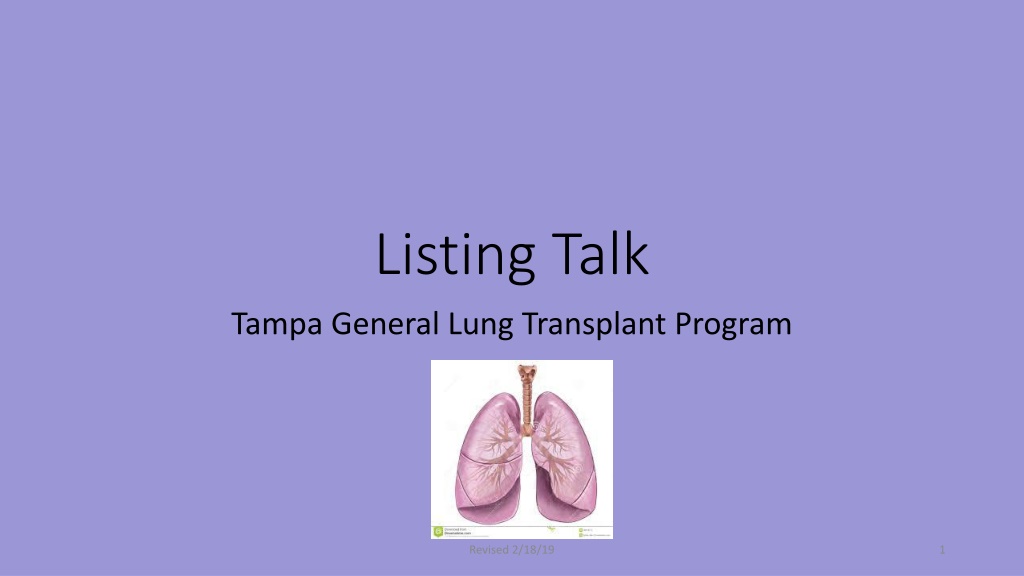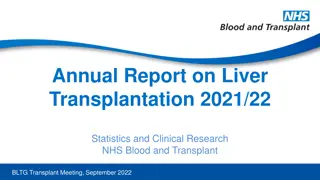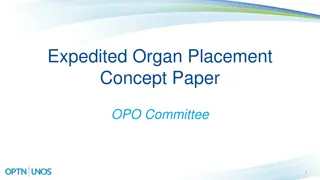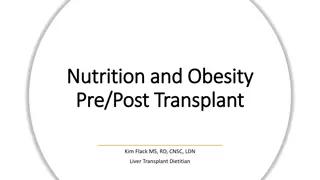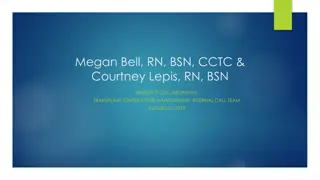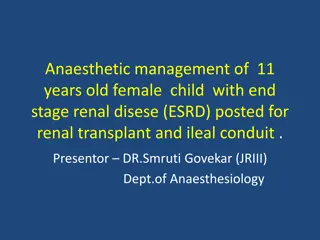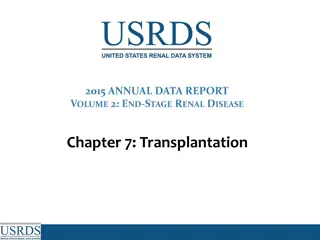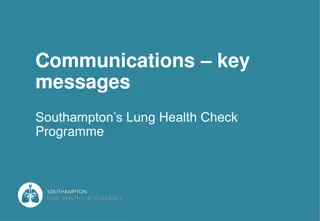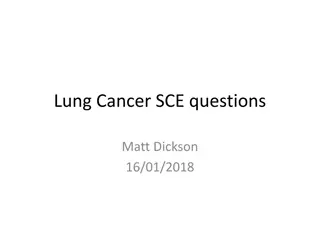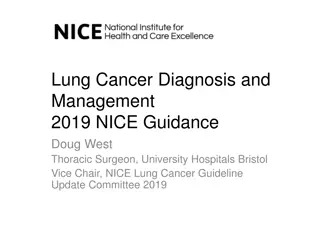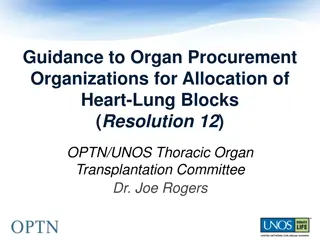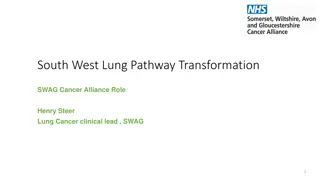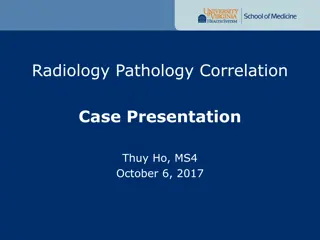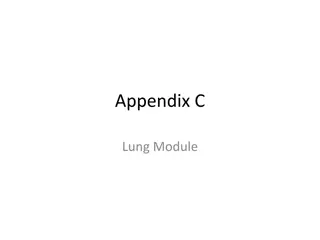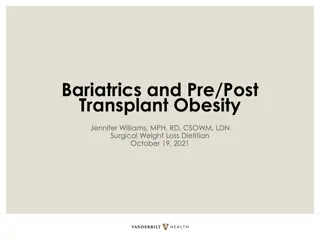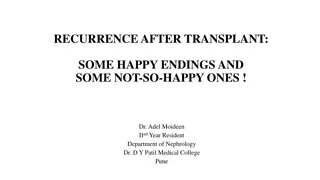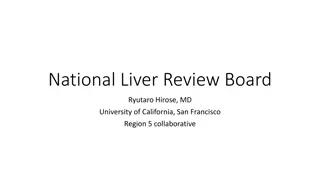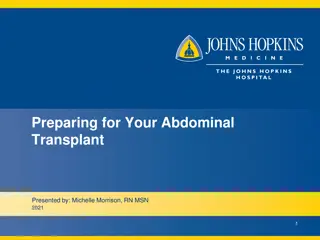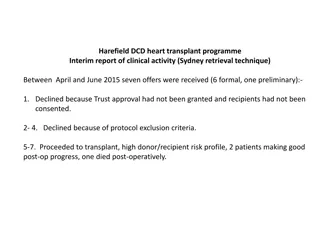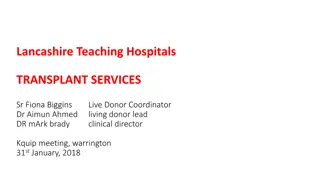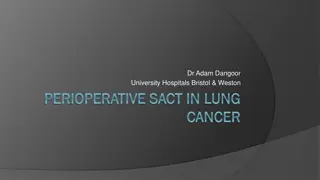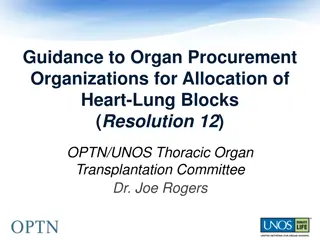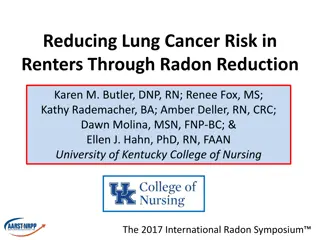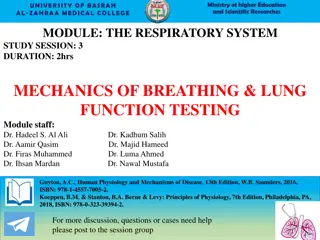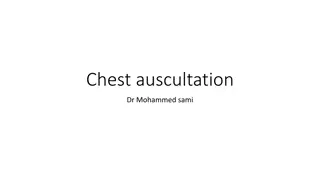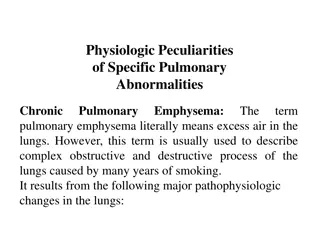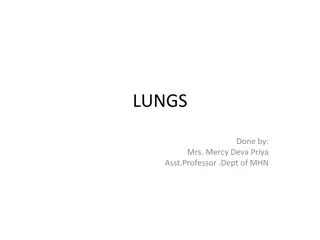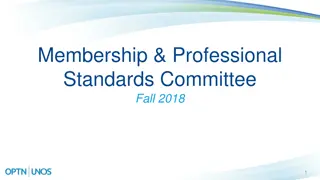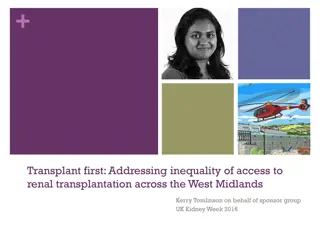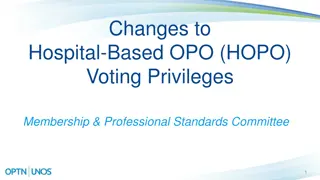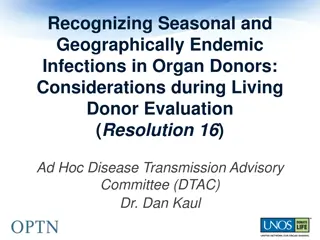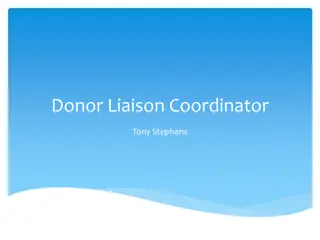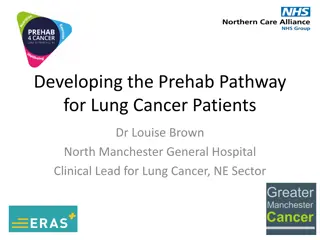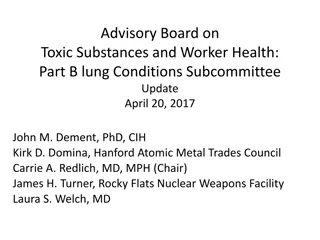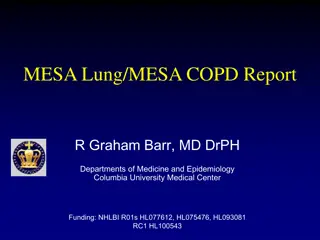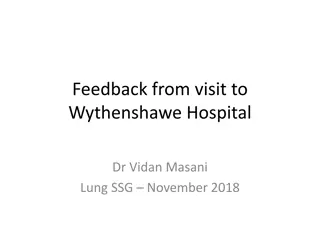Tampa General Lung Transplant Program Information Update
The Tampa General Lung Transplant Program aims to extend the lives of patients with irreversible lung diseases through timely transplants. The program emphasizes commitment to long-term health management, with a dedicated team of medical professionals providing comprehensive care. Patients are guided through pre-transplant requirements, contact information, and waiting protocols to ensure successful treatment outcomes.
Download Presentation

Please find below an Image/Link to download the presentation.
The content on the website is provided AS IS for your information and personal use only. It may not be sold, licensed, or shared on other websites without obtaining consent from the author. Download presentation by click this link. If you encounter any issues during the download, it is possible that the publisher has removed the file from their server.
E N D
Presentation Transcript
Listing Talk Tampa General Lung Transplant Program Revised 2/18/19 1
Purpose of Transplant Our goal is to extend your life as long as possible We want to transplant you at the right time, not too early and not too late You have a form of lung disease that is irreversible It is a lifetime of taking complex medications and a lot of stress from the demands of constant medical treatment and follow-up You must be committed to doing what is necessary to stay healthy Revised 2/18/19 2
Transplant Team Our Pre Lung Coordinators: Nicole Davis Lisa Dichiara Mitch Eton Pulmonologists: Dr. Kapil Patel Dr. Nirmal Sharma Guillermo Garrido Rosa Our Post Lung Coordinators Lindsey Hassett Sonja Olson Ida Delk Lesa Campbell Advanced Nurse Practitioners Tarcia McCray Stacy Stutts Desiree Bonnet Bilijana Vujovic Fran Robbibaro Cassandra Aldi Victoria Fransico Our Social Worker: Nicole Nevitt Xiomara Salamo Our Pharmacist: Angela Logan Our Surgeons: Dr. Robert Hooker Dr. John Dunning Erol Belli Our Dietician Yajaira Pluess Speech Therapist Alexis Benstock Revised 2/18/19 3
Contact Information Office hours are 8 am to 4:30 pm Monday through Friday Call during business hours for problems, issues, general needs, and prescription refills. Please allow 3 business days for prescriptions to be processed. We cannot fill prescriptions for narcotics after hours. On call coordinator after hours for Medical Emergencies only To contact the Lung Transplant Program, dial 813-844-7137, press 3 You will leave message with an assistant who will relay message to your coordinator. Please be as detailed as possible. Pre Clinic appointments are on Wednesdays Revised 2/18/19 4
Requirements for Transplant Work Up We look at you from a holistic approach: Medical, Social & Financial If issues or problems are identified, measures will be taken to support or rectify if possible. You may be made temporarily inactive until resolved. You are required to receive the following vaccines prior to listing Hepatitis A (1 shot) Hepatitis B (3 shots) Pneumovax or Previnar (1 shot) Tdap- Diphtheria, tetanus, and pertussis (1 shot) It is your responsibility to keep track of when vaccines are due You will need a scale, blood pressure monitor, pulse oximeter, and thermometer Revised 2/18/19 5
Waiting Protocol for Clinic & Testing Listing talk: mandatory for all patients and support team Held prior to UNOS listing Clinic appointments on Wednesdays every 2-3 months UNOS required testing will be repeated every 6 months ABGs, 6 minute walk test, complete pulmonary functions, labs, echo, and CT You will continue to be managed by your PCP and referring pulmonologist for health needs not related to your transplant listing Revised 2/18/19 6
Being Prepared You need to be prepared 24/7- Keep your cell phone charged and on Call may come from a blocked or private number Have alternative numbers and/or alternate contacts Always carry with you a current list of your medications Designate someone to contact others- make a list of people you want notified Map out a route to the hospital and have an alternative route- you must live within 4 hours of the hospital Bring your insurance cards, photo ID, med list, any glasses or hearing aides, enough oxygen to get you TO and FROM the hospital Keep enough cash on hand for parking ($3 for garage and $5 for Valet) Have reliable transportation available Revised 2/18/19 7
When The Call Comes Primary recipient: We have an offer of lungs for you, please come to the hospital immediately, do not eat or drink anything Back up recipient: We have an offer of lungs for someone else, there are special circumstances and we need to bring you in as back up You will both be prepared for surgery; you may receive medications such as antibiotics, steroids, & immunosuppressant's; they will not hurt you if you don t receive the lungs Revised 2/18/19 8
Increased Risk Donors You may be offered an organ from a donor that is considered to be at an increased risk for infection according the Public Health Services guidelines for recent HIV, Hep B or Hep C infections. We cannot divulge which criteria the donor meets, but the doctor will discuss the level of risk they feel is associated with accepting an organ from this donor You will be notified that the organ is high risk and be required to sign a consent Revised 2/18/19 9
Increased Risk Criteria Donor has a sexual history in the last 12 months with: A person with Hep B, C or HIV (or thought to have any of these illnesses); or A man (if donor is male), or if female, sex with a man known to have had sexual contact with men; or A partner in exchange for drugs or money; or A partner who has injected drugs for non-medical reasons in past 12 months The donor has injected drugs for non-medical reasons in past 12 months; or The donor has been in jail/juvenile detention for more than 3 consecutive days in the last year; or The donor is 18 months old or younger and is born to someone who meets the criteria above A donor who has been breastfed by someone who is know or suspected to be infected with HIV; or A donor who cannot be tested for HIV; or A donor has been treated for one or more sexually transmitted diseases in the past 12 months The person/people providing medical and social history of donor were not able to provide complete information Revised 2/18/19 10
Estimated Risk of HIV and HCV Transmission Risk per 10,000 donors HIV NAT HCV NAT Men who have sex with men 4.2 3.5 IV drug users 4.9 32.4 Risk of HIV and HCV infection occurring during the window period Hemophiliacs 0.035 0.027 Commercial sex worker 2.7 12.3 Virus Serology NAT Sex with a partner in above categories 0.3 12.3 HIV 22 days 9 days HBV 44 days 22 days Blood product exposure 0.6 0.4 HCV 66 days 7 days Incarceration 0.9 0.8 NAT detects viral genetic material rather than the immune response to the virus Revised 2/18/19 11
Comparative Risk Risk Factor Per 10,000 Being struck by lightning in your lifetime (80 years) 1 Dying in plane crash in your lifetime 2 Dying in a car crash 125 Dying crossing the street 16 Missing HIV with NAT 0.04-5 Missing HCV with NAT 0.03-32 Revised 2/18/19 12
Hepatitis C Virus Virus passed from person to person via blood-borne transmission Known to cause liver disease ranging in severity Due to advances in anti-viral therapy, Hep C now has >95% cure rate with a short course of oral medications It is considered a curable disease Revised 2/18/19 13
Risks with Hepatitis C Donors There is an almost 100% chance you will contract active HCV infection if the lung you receive comes from a person with active HCV infection With current therapies there is a >95% cure rate with 3-6 months of therapy Donor WITHOUT active HCV infection but history of exposure to HCV- risk of infection is thought to be extremely low. You will be monitored for infection with HCV. If active HCV develops then you will be started on medication to treat HCV. Revised 2/18/19 14
What is involved There is no additional or special cost associated with being listed for a Hep C donor Medications to treat HCV are widely covered by insurance. You will be required to sign consent to accept a Hepatitis C positive donor but you may change your mind at any time Your UNOS listing will reflect your decision Revised 2/18/19 15
Why Accept Hepatitis C Positive Donors Wait-time for an organ across the country is increasing There are over 114,000 people on the national transplant waiting list Accepting donors with active HCV expands the donor pool and has been shown to shorten the amount of time spent on the waitlist Your physician will discuss with you the potential risk and benefit specific to you No short term difference in survival compared to patients who receive a lung transplant from a donor without HCV infection- long term outcomes are yet to be determined Revised 2/18/19 16
Coming To The Hospital During normal business hours: go to main admissions After normal business hours: go to the ER Have family pack a bag with essentials (phone charger, snacks, medicine, blanket, sweater, book, etc) You will be admitted to a room for preparation for surgery You will have lab work, chest xray, EKG done Receive medications Sign Consent Meet with donor coordinator Meet with Cardiothoracic surgeon Revised 2/18/19 17
Pre-Op Holding Your surgeon will determine the time you will be moved to the pre-op holding area This is determined by location of your donor and arrival time of the lungs Donor OR times are delayed frequently Your family will be able to visit before you go back for surgery The team will be busy placing an arterial line and IV lines Family will need to wait in the CTICU waiting area on 3rd floor You wait in the pre-op area until we get a call from the surgeon indicating the condition of the lungs from inside- Visualization Revised 2/18/19 18
Visualization & Surgery Procuring surgeon will examine the donor lungs and assess final bronch and ABGs At this point, you will either be taken to the OR or sent home We do not want to give you lungs that will not be good its hard but we want you to survive and do well after transplant Bilateral Lung transplant: estimated 6-8 hours Single Lung transplant: estimated 4 hours Revised 2/18/19 19
Immediately Post Op You will be taken immediately to the ICU You may look different: pale, swollen, puffy Your wrists will be tied with soft restraints for your safety and to prevent you from pulling out any lines or tubes When you wake up you will have a tube down your throat that is helping you breath and you will not be able to talk We will keep you sedated at first and slowly wean you off in preparation for extubation Usually occurs about 12 hours after surgery and takes 3-6 hours Important to remain calm and not fight the ventilator Revised 2/18/19 20
Post Op You will have many lines and tubes Chest tubes: 2-4 Foley Arterial line to measure blood pressure and draw blood gases Central line and peripheral IVs for medication administration SCDs Your lungs will feel stiff to begin with and you will require some oxygen while recovering You will remain in the ICU for 2-5 days and transplant floor 5-10 days on average Revised 2/18/19 21
Transplant Floor When you are stable you will be moved to our transplant floor You will always need a private room now that you are transplanted You may require some oxygen while recovering You will work with physical therapy, occupational therapy, pulmonary rehab, and speech therapy to increase your activities You will get stronger and your activity will improve Revised 2/18/19 22
Education You will have teaching prior to discharge to include: Discharge education Nutrition Medication Diabetes You will be given an educational binder where you will record daily your vitals signs, weight, and blood sugars You will bring this with you to every clinic appointment Pill box will be done with pharmacist on day of discharge Revised 2/18/19 23
Discharge You will be seen in post transplant clinic after discharge Twice a week - 1 month Weekly - 2nd month Every other week - 3-6 months Every 4 weeks 7-9 months Every 6 weeks 10-12 months Every 3 months thereafter You will be required to live within one hour for first 2-3 weeks after discharge You will be required to have 24/7 support for first 3 months post transplant Revised 2/18/19 24
Long Term Complications Adverse effects due to immunosuppressive drugs including but not limited to: Hypertension New development of diabetes or worsening of current diabetes Worsening kidney function which may lead to temporary or permanent requirements for renal replacement therapy (dialysis) Abnormalities in liver function Bone marrow suppression with abnormalities in blood counts Nervous system toxicity including headaches and/or tremors High cholesterol and/or triglyceride levels Osteoporosis Muscle weakness Glaucoma Accelerated cardiovascular disease Revised 2/18/19 25
Lung Allocation Score Important factor in determining priority for receiving a lung transplant when a donor lung becomes available Calculated using age, BMI, lung disease, oxygen use at rest, assisted ventilation, pulmonary function values, right heart cath measurements, functional status, 6 minute walk distance, lab values, ABG results Score 0-100: estimates severity of each candidates illness and chance of success after transplant Re-evaluated every 6 months or as needed Revised 2/18/19 26
When to Call Temp 99.5 to 100.4 for 24 hours without taking Tylenol Temperature 100.5 or greater requires an immediate phone call Chills, shaking, or night sweats Changes in oxygen requirements, either at rest or with exertion Nausea, vomiting, or diarrhea lasting more than 24 hours If you are exposed to mumps, measles or chicken pox If you forget a dose of medication When you receive a new medication from a consulting doctor Increased fatigue or weakness Decreased exercise tolerance Constipation, abdominal pain or loss of appetite Persistent cold, flu-like symptoms, scratchy or sore throat Blood pressure less than 90 or greater than 150 systolic Burning pain upon urination, foul smelling urine Weight gain 3-5 lbs. over night Redness, drainage or swelling around incision, cut or wound Revised 2/18/19 27
